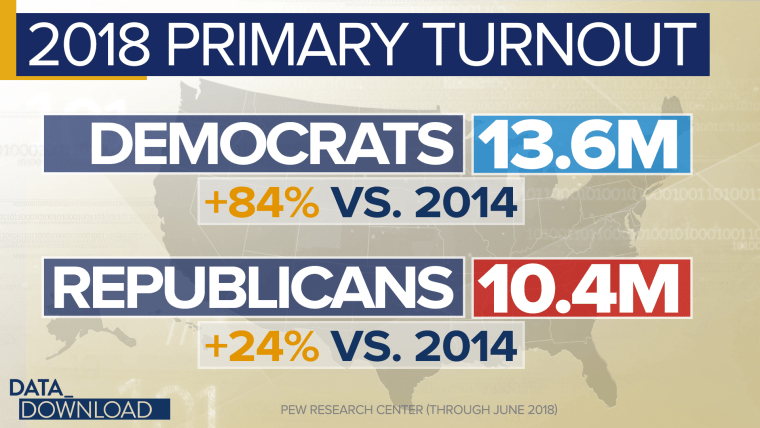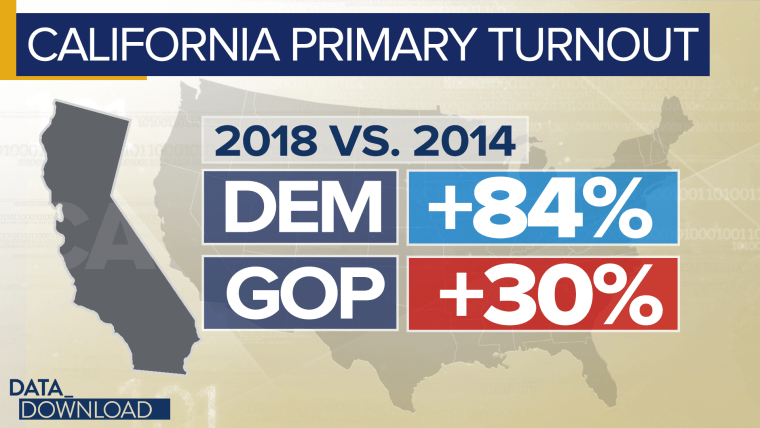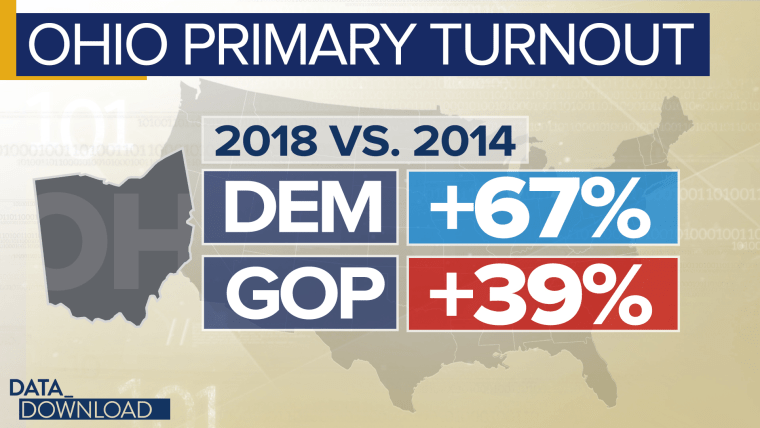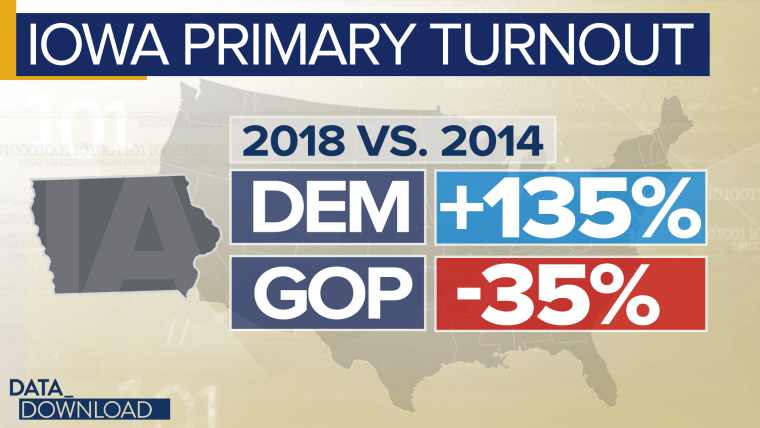WASHINGTON — As the 2018 primary season has rolled through the spring and summer, Democratic enthusiasm and turnout has been a dominant story in state after state, from New York to California. This week, the Pew Research Center put all those state-level stories into a national context with some eye-grabbing numbers.
The Pew analysis found that through June, 13.6 million people had voted in Democratic House primaries in 2018. The number was 7.4 million in 2014, the last midterm election. The 2018 figure represents an 84 percent increase over 2014.
The Republican House primary vote has climbed as well in 2018, but not by the same amount. Thus far about 10.7 million votes have been cast in GOP House primaries, compared to 8.6 million in 2014. That’s a bump of about 24 percent.

To be clear, primary votes are often very different animals than general elections. Primaries are sometimes driven by intra-party competition. But the numbers at least provide a rudimentary measure of how engaged voters are.
And the House primary numbers not only show a bigger Democratic bump, they show that more people have voted in Democratic House primaries than Republican House primaries in 2018 — flipping the script from 2014. (The same 31 states will have voted in both years.)
The Pew analysis also found the Democratic primary vote surging in Senate and gubernatorial races, but the House vote numbers were especially noteworthy. In part, they are the result of Democrats fielding challengers in more districts around the country, energizing their voters.
But the national numbers don’t tell the whole story, particularly in midterm elections where specific candidates and unique district dynamics can play a big role. And in individual states and districts, the numbers can look different. Consider three states with important battleground House districts in 2018: California, Iowa and Ohio.
California:
By most standards, the numbers for California Democrats are very good in 2018. Turnout among Democrats in that state’s House primaries on June 5 was up 84 percent compared to 2014. Turnout was up for Republicans, too, but by much less, only about 30 percent.

And that just further exacerbated the Democratic primary vote advantage in the state, to nearly 2 million in 2018, compared to about 525,000 in 2014.
But maybe most important, in nine of the 10 congressional districts seen as battlegrounds by the Cook Political Report, the Democratic primary vote surge was bigger than the Republican surge. Republicans may have reason to be hopeful as well, however. In most of those House battlegrounds, more people still voted in the Republican primary.
Ohio:
The story is a bit more complicated for Democrats in Ohio. Again, the number of both Democratic and Republican primary voters grew in 2018, but here, the GOP still seems to have an edge. Democrats got the bigger bump in Ohio, a 67 percent increase in primary voters compared to a 39 percent increase for Republicans. But, overall, Republicans still held the advantage in total votes cast, 755,000 versus 604,000 for the Democratic primaries.

Democrats may see something to like here in the state’s more closely contested districts. In four of those five battlegrounds, the Democratic primary saw the bigger increase in votes. But in all five districts there were more votes cast overall in the Republican primary.
Tuesday’s special election to fill the seat in Ohio’s 12th district, a Republican seat that is currently rated as a tossup by the Cook Political Report, may offer clues to what these primary numbers will mean in Ohio in the fall. The 12th saw a remarkable 144 percent increase in the Democratic primary vote in the state’s May 8 primary compared to 2014, but the district still has a heavy Republican lean. If Democrat Danny O’Connor wins, or even gets to low single digits, it’s a sign those big primary numbers have some weight in the state.
Iowa:
Of all the numbers here, Iowa’s may be the most interesting. The Democrats saw a big increase in their House primary vote in the state, while Republicans saw a steep drop. Some of that undoubtedly had to do with the lack of contested races on the Republican side of the slate, but the numbers are still remarkable.

Overall, 110,000 more people voted in the Democratic primaries in 2018 than in 2014 — a 152 percent increase. Meanwhile, 57,000 fewer people voted in the state’s Republican House primaries this year than did four years ago.
And the lack of contested races doesn’t explain all of the drop-off. For instance, in Iowa’s 2nd District, where both the Democrat and Republican were unopposed, the Democratic primary increased by 27,000 voters, while the Republicans had a decline of more than 8,000.
That difference in enthusiasm could spell trouble for Republicans in two House seats currently rated as tossups by the Cook Political Report. In both those races, which were contested on the Democratic side and not on the Republican side, Democratic turnout was up sharply compared to 2014.
Taken together, these state-level numbers suggest that the big primary vote bump for the Democrats is impressive but its November impact is still hard to read.
Republicans, who hold the House, were more likely to have incumbents on the ballot this primary season and those incumbents were less likely to have challengers — or at least serious challengers. And Democrats, who fielded more candidates this year, were bound to see a bump in the primary vote.
But Republicans also held the House in 2014, when they had much better primary numbers. The state-level data show a more complicated landscape than the big national numbers but, at the very least, the state results suggest Democratic voters are much more tuned in the 2018 midterms than they were four years ago.